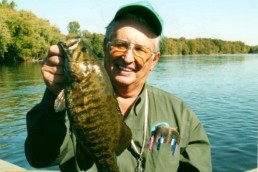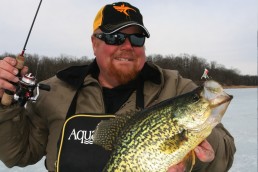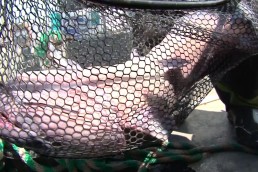Underwater Camera Reveals Real Fish Secrets
SHARE THIS POST
During the last five years, I’ve spent more time studying the monitor of our underwater camera system than actually fishing. It has been enlightening like nothing else in all my years of fishing.
That’s not to say that those warm sunny afternoons splashing through the waters of the creek running through my father’s turkey farm in central Minnesota didn’t provide knowledge. Those days provided a happy, playful look at the world of fishing. These past five years, with my eyes glued to the video monitor, filled my mind with the wonders of the underwater world of fish.
From the time I announced that a school of walleyes had appeared on the video screen to my constant fishing companion, Dan Gapen, Sr., countless startling happenings have come to view. That day, on the upper Mississippi in 2011, was when Dan and I first found the Benthic River Zones we wrote about in the first three issues of MidWest Outdoors in 2016.
Many and varied discoveries
Since that time, we discovered a goodly number of tactics used by freshwater fish, such as the Bump and Stun. This maneuver was intently observed on a lake called Kagianagami, where deep-water walleyes rise off bottom to feed on ciscoes. Ciscoes in Kag suspend at 20 feet, 24 hours a day. The black-backed walleyes rise from 90 to 110 feet of water late each day (about 4 p.m.) to feed on the reliable meals.
With a river system running through Kagianagami, there is no summer thermocline, so stratified layers of water temperature and oxygen do not restrict vertical fish movements. Most of what I noted regarding this lake, like so many others, needs more underwater research. I suspect that the bottom of Kag is loaded with Benthic Zones, because of the deep currents from which the walleyes rise.
Then there’s the “Eyeing Up” of baits by pike, walleyes and other species that Dan exposed in the April issue. Our underwater cameras saw that activity on a River called Ogoki, which runs across central northern Ontario. Once again, Dan and I were researching our New Spin Bee Lure and the Benthic Zone structure when this occurred.
As I mentioned at the beginning of this column, much of my time on the water during the last five years has been spent exploring the underwater world with special video gear. Much of what that underwater filming exposed will be written about in future articles. I believe the most fascinating exposure was what we found on lake trout. Where they hold in the lake, what baits attract them and when they bite.
Even though Dan’s bad back has been a challenge for us this summer, we’ve managed to do some underwater filming. Much of it has focused on our new Flick Fly and how deadly this lure is on rough fish such as suckers and carp. This new approach to fishing these kinds of fish with an artificial lure began three years ago, when I saw that suckers and carp were eager to attempt feeding on our Spin Bees. Even then, most of the strikes by these fish saw them miss. Why? Most likely the sucker or carp blew the Spin Bees out of their mouths. When I showed Dan the film, he confirmed that the Spin Bee maybe was too heavy, thus the rejection from the suckers.
Are you enjoying this post?
You can be among the first to get the latest info on where to go, what to use and how to use it!
Solution? Lighten the lure’s weight.
“‘Bobber,’ I’ve got an idea,” he said. “I’ll tie one up when we get home. No more rejects by those redhorse suckers. Like my mom always said, keep the redhorse suckers to be made into fish patties for winter.”
At the time, I wasn’t too sure what he meant, but knew that he’d come up with something that would work.
Two days later, as we worked the same spot on the Mississippi, he proved his theory and the Gapens had another first in their history. We had an artificial lure that would catch rough fish. I’ll leave the exposure of that tale to Dan, who is well into a three-part series on the theories that led to development of the new lure (which is mostly like a fly), and how and where it works.
We love tempting and battling rough fish, but the new lure catches any species we’ve tried it on. You can read part one, full of new secrets on the Flick Fly will increase your catch, in the January, 2017 issue of MidWest Outdoors.
We’ll, I’m off to do more underwater filming. Dan and I are following up our earlier filming projects on river zones. There’s more to learn as I record and document the fascinating things fish do.
We’re also doing more testing on that new fly, which can be used on a spinning rod or fly rod. Our experiences have been amazing, and we can’t wait to share them with you. They have the potential to change how you think about fishing, and how much joy you get from it.
MWO
SHARE THIS POST
Did you enjoy this post?
You can be among the first to get the latest info on where to go, what to use and how to use it!
'Bobber' Anne Orth
Known in the fishing world as ‘Bobber’ Anne, she has co-hosted countless TV fishing & hunting shows, throughout the Americas, since 1991. Her primary efforts include filming fish strikes on underwater video, giving family seminars, writing articles, and conducting sales for Gapen Tackle Company. In 2018, she was inducted into the National Fresh Water Fishing Hall of Fame.



